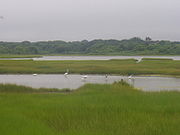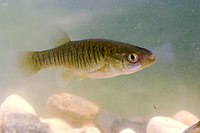

|
No edit summary
|
added/Aedes sollicitans
|
||
| Line 26: | Line 26: | ||
'''Salt marsh mosquito panne''' |
'''Salt marsh mosquito panne''' |
||
Minimal vegetation often found on the upper half of the high salt marsh. It is typically deeper than forb and smooth cord-grass pannes. Usually flooded by the higher of the two [[spring tide]]s, retains water for 2-3 weeks later until drying out. The female salt marsh |
Minimal vegetation often found on the upper half of the high salt marsh. It is typically deeper than forb and smooth cord-grass pannes. Usually flooded by the higher of the two [[spring tide]]s, retains water for 2-3 weeks later until drying out. The female eastern salt marsh mosquito (''[[Aedes sollicitans]]'') lays eggs on the exposed surface. The eggs lay dormant until the next time the panne floods. |
||
[[File:Fundulus heteroclitus.jpg|thumb|right|200px|Mummichogs, [[Mummichog|(Fundulus heteroclitus)]], found in deepwater pools]] |
[[File:Fundulus heteroclitus.jpg|thumb|right|200px|Mummichogs, [[Mummichog|(Fundulus heteroclitus)]], found in deepwater pools]] |
||
Widgeon grass (''[[Ruppia maritima]]'') - marsh minnow deepwater pool |
Widgeon grass (''[[Ruppia maritima]]'') - marsh minnow deepwater pool |
||

Salt pannes and pools are water retaining depressions located within salt and brackish marshes. Pools tend to retain water during the summer months between high tides, whereas pannes generally do not. Salt pannes and pools are unique microhabitats dominated by various species of halophytes, benthic plants and varying estuarine marine life that vary considerably in composition due to a variety of factors:
These factors affect the types of species which can survive within the various types of salt pannes and pools.
Variants of salt pannes and pools:
Low salt marsh

Usually devoid of vegetation, that may be present include smooth cordgrass (Spartina alterniflora), marine algae such as knotted wrack (Ascophyllum nodosum) and rockweeds (Fucus spp.). The substrate is typically soft, silty mud.
High salt marsh
Briefly-flooded, very shallow with a moderate amount of vegetation usually dominated by Arrow grass (Triglochin maritimum), with the deeper sections possibly remaining unvegetated.
Shallow anaerobic depressions with poor drainage, poor water quality due to low nutrient levels and high concentrations of sulfides and similar compounds which inhibit plant growth. Short form (6-12" tall)smooth cord-grass (Spartina alterniflora) is the dominant plant species. Typically found on the high salt marsh, but can occasionally be found on the upper margins of low salt marsh.
Salt marsh mosquito panne
Minimal vegetation often found on the upper half of the high salt marsh. It is typically deeper than forb and smooth cord-grass pannes. Usually flooded by the higher of the two spring tides, retains water for 2-3 weeks later until drying out. The female eastern salt marsh mosquito (Aedes sollicitans) lays eggs on the exposed surface. The eggs lay dormant until the next time the panne floods.

Widgeon grass (Ruppia maritima) - marsh minnow deepwater pool Pools on the high salt marsh that are semi-permanently and permanently flooded. They are able to sustain populations of Sheephead minnow (Cyprinodon variegatus variegatus), Mummichogs, (Fundulus heteroclitus), and other species of small fish which may become trapped in the pools and benthic species of vegetation. Occasioanally can be found at the upper edge of the low salt marsh.
Brackish marsh panne variants occur in brackish marshes (short graminoid variant), one of the native dominant species is spike grass (Distichlis spicata), some brackish marsh pannes are dominated by the narrow-leaved cattail (Typha angustifolia) an invasive exotic species.
Shallow depressions flooded for only for a brief time and are characterized by a variable mix of graminoids and forbs. Frequent herbs include three-square rush (Scirpus pungens), stout bulrush (S. robustus), arrow-grass, marsh creeping bent-grass (Agrostis stolonifera), salt-loving spike-rush (Eleocharis halophila). Growing with less frequency are red fescue (Festuca rubra), New York aster (Symphyotrichum novi-belgii) silverweed, saltmeadow cordgrass (Spartina patens), and salt marsh rush.

Saturated, mud dominated pannes which are occassionally in transition zone next to forested uplands where they are shaded by overhanging tree branches thus inhibiting evaporation. This is the preferred habitat for the uncommon seaside crowfoot (Ranunculus cymbalaria), where prostrate colonies may form small patches over the soil surface. Other graminoids and forbs scattered across the mud, or more often around the panne edge, include Virginia wild rye (Elymus virginicus), chaffy salt sedge (Carex paleacea) seaside goldenrod (Solidago sempervirens), marsh creeping bent grass, New York aster and smooth cordgrass.[1][2]
|
| ||
|---|---|---|
| Landforms |
| |
| Beaches |
| |
| River mouths |
| |
| Processes |
| |
| Management |
| |
| Related |
| |
| ||